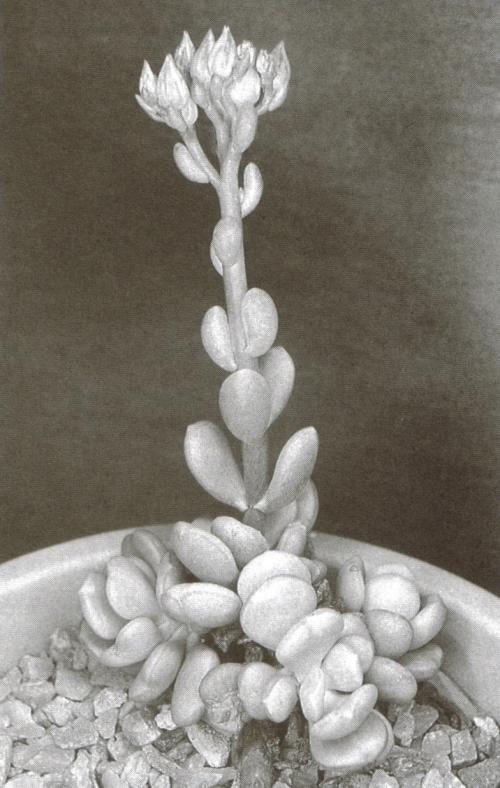LAXUM (Britton) Berger, 1930
Synonyms :
Gormania laxa Britton (1903)
Cotyledon brittoniana Fedde (1904)
Echeveria gormanii Nelson & Macbride (1913)
Sedum jepsonii (Butterfield (1936)
Sedum laxum ssp. typicum Clausen (1942)
Distribution : Western USA
Description (by 't Hart & Bleij in IHSP, 2003) :
Glabrous perennial herbs with stout branched rootstocks forming terminal rosettes.
Leaves alternate, oblanceolate, spatulate or obovate, rounded, emarginate or retuse, 14,5 - 36 x 7,5 - 17 mm, glaucous or green.
Inflorescences : Flowering branches 7 - 26 cm, inflorescences elongate cymes with 3 or more monochasial branches, pedicels 0,6 - 6,3 mm.
FIowers 5-merous, sepals broadly sessile, basally slightly connate, ovate or lanceolate, acute, rarely obtuse, pale green, ± 3,5 x 2 mm, petals basally connate, lanceolate-oblong, oblanceolate-oblong or elliptic-oblong, obtuse, shortly mucronate or aristate, whitish to pink, ± 9 mm, basally erect, divergent above the middle, filaments white, greenish-white or pink, anthers red or yellow.
Ray Stephenson (Sedum, Cultivated Stonecrops, 1994, pp 200 - 202):
Common name : Rose-flowered stonecrop
From the list of synonyms, one can see some of the controversy that this polymorphic species has caused. Fusion of petals for about half their length is not a feature usually associated with Sedum. Very rarely seen in Europe, this pink- or white-flowered species is highly succulent with relatively few exceptionally turgid leaves clustering in basal 4-cm (2-in) rosettes. Stems of S. laxum rise from a fleshy rootstock. Offsets often have opposite-decussate leaves at first as new rosettes form. Glabrous inflorescences of late summer can be very long, but are usually about 15 cm (6 in) long. Branches of inflorescence are incurved at first, and flowers have erect petals with as much as 3/5 cohesion.

Sedum laxum with a 12-cm (5-in) long inflorescence.
Habitat : From Josephine County, southern Oregon, to Mendocino and Lake counties of northern California, this stonecrop is found on rocky sites in valleys, from less than 200 m (700 ft) elevation in the north to nearly 1800 m (5900 ft) in the south of its range.
Main points of distinction : Very succulent leaves (Leaf shapes, fig. 5f), and pink or white flowers with upright petals, connate for about half their length, are the best indicators. Sepals are upright, pressed against flower tubes. Carpels are erect then only spread a little in fruit. Nectaries are broader than long, and almost two-lobed.
Variation : This is such a varied species that one school of thought suggests that every distinct, disjunct population deserves its own name. The descriptions that follow are very general and include almost all variations recorded from the wild. According to Clausen (1975), there are four subspecies worthy of note in cultivation, although intermediate forms exist in the wild that often are difficult to assign to a specific subspecies. So many transitional populations exist that specific status for any form is questionable.
2 subspecies :
Sedum laxum ssp. heckneri (M. Peck) R. T. Clausen (1942)
Petals of all subspecies are sometimes wavy or even eroded. Out of flower, any can easily be confused with other North American species.
Horticulture : This beautiful, highly succulent species struggles for survival in Northumberland, but thriving outdoor colonies have been established near the east coast of northern Scotland. It should do well in an alpine house or cold frame in most areas, but Clausen reported this was not so in New York State.
See also S. moranii and A review of Sedum section Gormania (Crassulaceae) in western North America, in Phytotaxa 368 (1): 1-61, 2018.
Note :
1. The former S. laxum ssp. eastwoodiae has been re-classified as a species : S. eastwoodiae, published in Phytotaxa 368 (1): 1-61, 2018.
2. The former S. laxum ssp. flavidum has been re-classified as a species : S. flavidum, published in Phytotaxa 368 (1): 1-61, 2018.
3. The former S. laxum ssp. latifolium is now considered a synonym of S. laxum ssp. laxum, published in Phytotaxa 368 (1): 1-61, 2018.